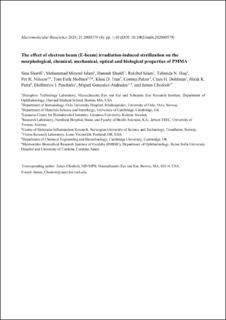| dc.contributor.author | Sharifi, Sina | |
| dc.contributor.author | Islam, Mohammad Mirazul | |
| dc.contributor.author | Sharifi, Hannah | |
| dc.contributor.author | Islam, Rakibul | |
| dc.contributor.author | Huq, Tahmida N. | |
| dc.contributor.author | Nilsson, Per | |
| dc.contributor.author | Mollnes, Tom Eirik | |
| dc.contributor.author | Tran, Khoa D. | |
| dc.contributor.author | Patzer, Corrina | |
| dc.contributor.author | Dohlman, Claes H. | |
| dc.contributor.author | Patra, Hirak K. | |
| dc.contributor.author | Paschalis, Eleftherios I. | |
| dc.contributor.author | Gonzalez-Andrades, Miguel | |
| dc.contributor.author | Chodosh, James | |
| dc.date.accessioned | 2022-09-08T12:15:33Z | |
| dc.date.available | 2022-09-08T12:15:33Z | |
| dc.date.created | 2021-06-18T13:10:24Z | |
| dc.date.issued | 2021 | |
| dc.identifier.citation | Macromolecular Bioscience. 2021, 21:2000379 (4), 1-10. | en_US |
| dc.identifier.issn | 1616-5187 | |
| dc.identifier.uri | https://hdl.handle.net/11250/3016621 | |
| dc.description.abstract | Electron beam (E-beam) irradiation is an attractive and efficient method for sterilizing clinically implantable medical devices made of natural and/or synthetic materials such as poly(methyl methacrylate) (PMMA). As ionizing irradiation can affect the physicochemical properties of PMMA, understanding the consequences of E-beam sterilization on the intrinsic properties of PMMA is vital for clinical implementation. A detailed assessment of the chemical, optical, mechanical, morphological, and biological properties of medical-grade PMMA after E-beam sterilization at 25 and 50 kiloGray (kGy) is reported. Fourier transform infrared spectroscopy, thermogravimetric analysis, and differential scanning calorimetry studies indicate that E-beam irradiation has minimal effect on the chemical properties of the PMMA at these doses. While 25 kGy irradiation does not alter the mechanical and optical properties of the PMMA, 50 kGy reduces the flexural strength and transparency by 10% and 2%, respectively. Atomic force microscopy demonstrates that E-beam irradiation reduces the surface roughness of PMMA in a dose dependent manner. Live-Dead, AlamarBlue, immunocytochemistry, and complement activation studies show that E-beam irradiation up to 50 kGy has no adverse effect on the biocompatibility of the PMMA. These findings suggest that E-beam irradiation at 25 kGy may be a safe and efficient alternative for PMMA sterilization. | en_US |
| dc.language.iso | eng | en_US |
| dc.publisher | Wiley | en_US |
| dc.title | Electron Beam Sterilization of Poly(Methyl Methacrylate)—Physicochemical and Biological Aspects | en_US |
| dc.type | Peer reviewed | en_US |
| dc.type | Journal article | en_US |
| dc.description.version | acceptedVersion | en_US |
| dc.rights.holder | This is the authors' accepted manuscript to an article published by Wiley. | en_US |
| dc.source.pagenumber | 1-10 | en_US |
| dc.source.volume | 21:2000379 | en_US |
| dc.source.journal | Macromolecular Bioscience | en_US |
| dc.source.issue | 4 | en_US |
| dc.identifier.doi | 10.1002/mabi.202000379 | |
| dc.identifier.cristin | 1916748 | |
| dc.relation.project | Norges forskningsråd: 223255 | en_US |
| cristin.ispublished | true | |
| cristin.fulltext | postprint | |
| cristin.qualitycode | 1 | |
